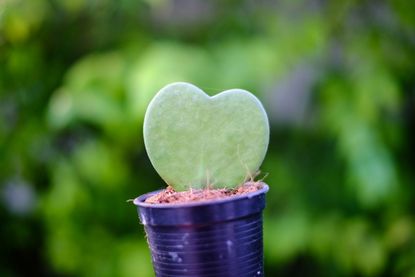Care Of Sweetheart Hoya Plant: Growing Valentine Hoya Houseplants


Sweetheart hoya plant, also known as Valentine plant or sweetheart wax plant, is a type of Hoya appropriately named for its thick, succulent, heart-shaped leaves. Like other Hoya varieties, the sweetheart hoya plant is a stunning, low-maintenance indoor plant. Read on for additional wax plant info.
Hoya Wax Plant Info
Native to Southeast Asia, sweetheart hoya (Hoya kerrii) is often a quirky Valentine's Day gift with a single 5-inch (12.5 cm.) leaf planted upright in a small pot. Although the plant is relatively slow-growing, it appreciates a hanging basket, where it eventually becomes a bushy mass of green hearts.
Mature plants can reach lengths of up to 13 feet (4 m.). During the summer, clusters of white, burgundy-centered blooms provide a bold contrast to the deep green or variegated leaves. One mature plant can display up to 25 blooms.
How to Grow a Sweetheart Wax Plant
Sweetheart hoya care isn't complicated or involved, but the plant is somewhat particular about its growing conditions. This Valentine hoya tolerates relatively low light, but not full shade.
However, the plant performs best and is more likely to bloom in bright or indirect sunlight. Room temperatures should be maintained between 60 and 80 F. or 15 and 26 C. With its fleshy, succulent leaves, sweetheart hoya is relatively drought-tolerant and can get by with as little as one or two waterings per month.
Water deeply when the soil is slightly dry to the touch, then let the pot drain thoroughly. Although the soil should never become bone dry, wet, soggy soil can result in deadly rot. Be sure sweetheart hoya is planted in a pot with a drainage hole.
Sweetheart hoya is a light feeder and requires little fertilizer. A light solution of a balanced, water-soluble houseplant fertilizer mixed at a rate of ¼ teaspoon (1 ml.) in a gallon (4 L.) of water is plenty. Feed the plant once a month during the growing season and discontinue feeding in winter. If a mature plant doesn't bloom, try exposing the plant to brighter light or cooler nighttime temperatures.
Gardening tips, videos, info and more delivered right to your inbox!
Sign up for the Gardening Know How newsletter today and receive a free download of our most popular eBook "How to Grow Delicious Tomatoes."

A Credentialed Garden Writer, Mary H. Dyer was with Gardening Know How in the very beginning, publishing articles as early as 2007.
-
 Grow a Bathroom Oasis: 8 Best Bathroom Plants With No Light or Low Light
Grow a Bathroom Oasis: 8 Best Bathroom Plants With No Light or Low LightSome apartment dwellers grow the best bathroom plants with no light or low light. Read how one of our favorite plant lovers does it in the big city.
By Teo Spengler
-
 "My Worst Mistake" – Gardeners Share 10 Hard-Learned Lessons
"My Worst Mistake" – Gardeners Share 10 Hard-Learned LessonsGardeners never stop learning, and sometimes our mistakes are the best teachers. But why not save time and heartache by learning from other gardeners' failures?
By Melanie Griffiths